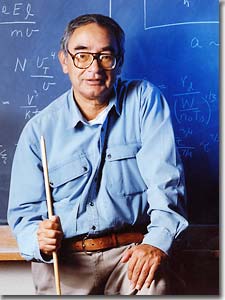Fred Begay
Ancient Navajo thought contains many parallels to modern scientific concepts, including radiation (Tsa'jilgish in the Navajo language), and lasers (Hatsoo'algha k'aa'), according to Navajo physicist Fred Begay, who has spent hundreds of hours translating and making the connections between traditional Navajo beliefs and modern science. He has done this in addition to his research in nuclear physics and his numerous outreach and education efforts to help the Native American community.
Begay was born in 1932 on the Ute Mountain Indian Reservation in Colorado. His parents, who were Navajo and Ute healers and spiritual leaders (Hataaliis), taught him traditional Navajo ceremonies. “ It turns out many of the prayers and songs have built in lots of science,”says Begay. “I was immersed in all that knowledge before I even got to the first grade. ”

Navajo physicist Fred Begay derived a new electron temperature scaling law for laser-produced plasmas at Los Alamos National Laboratory
At age ten, Begay was sent away from home to a government-run vocational school, where his teachers decided to train him in farming. Begay and his family didn't have any choice in what he studied, he says. “Our parents didn't speak English, so they couldn't say, 'I want him to take physics.' ”
School officials discouraged the students from practicing the Navajo language and culture, forcing them to speak English and attend a Christian church. “The first day at the federal government Indian school,” Begay remembers, “they told us that the Navajo language was inferior, that our religion was inferior, that our culture was inferior, that we should not participate in it any more from that day on, that we would be punished if we were caught praying in the Navajo language.”
In 1951, after eight years learning to be a farmer, Begay joined the U.S. Air Force and fought in the Korean War. When he returned, with funding from the Department of Veterans Affairs, Begay enrolled at the University of New Mexico in 1955. To make up for his lack of a standard pre-college education, Begay had to take high school classes in the evenings while attending college courses during the day.
Not having attended high school, Begay was unfamiliar with academic subjects. “I had no knowledge of physics, or math, or English, or any of that,” he says. So his decision to study physics was “just an accident,” he says.
He continued to pursue the subject, and after receiving a PhD in nuclear physics from the University of New Mexico in 1972, he joined the research staff of Los Alamos National Laboratory.
Much of Begay’s research has focused on controlled thermonuclear fusion. Fusion in plasmas- hot ionized gases- could potentially provide a clean, practically unlimited energy source as an alternative to fossil fuels. But plasma physicists have been trying unsuccessfully for decades to build a reactor that puts out more energy than it takes in. Begay has recently been investigating a phenomenon called “soliton turbulence,” that he believes might cause instabilities in the plasmas, making them useless for fusion. He hopes his research will help point to ways to avoid these problems.
Though he didn’t receive a standard high school education, Begay believes that in some ways the Navajo culture helped prepare him to study science. “I think the key point is that I learned to think abstractly and develop reasoning skills when I was growing up, learning about lasers and radiation in the Navajo language,” he says, “That’s all embedded in our religion.”
The Navajo do not have separate words to refer to religion and science. Instead, they have a single concept they call “the sacred depths of nature” which encompasses their beliefs about the natural world. “We strongly rely on natural phenomena. We believe we’re children of nature,” says Begay.
Over the course of ten years from 1972 to 1982, Begay spent hundreds of hours investigating the relationship between traditional Navajo thought and modern science. For instance, in addition to Navajo concepts corresponding to the modern ideas of radiation and lasers, he has found parallels with relativity, space-time physics, and quantum mechanics.
“But [these ideas] are buried in our own abstract language,” says Begay, and it is not easy to translate them into English. “If I say to you ‘Hatsoo’algha k’aa,’’ you’d have no idea what I’m talking about,” says Begay. “It’s taken decades for me to make the correlation.” In some cases, however, no clear parallels exist, he says. “The Navajo has mysterious ideas about science which cannot be interpreted into English. ”











